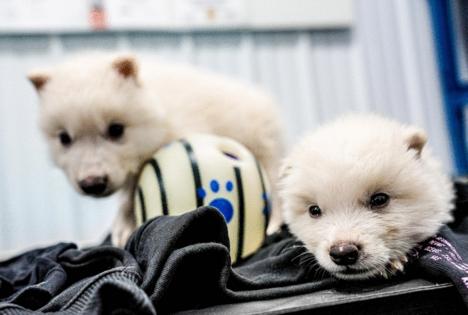Michael Hiltzik: This genetics firm didn't resurrect the extinct dire wolf, but did achieve a breakthrough in hype
Published in Business News
Anyone weary of the fire hose of dire news from the White House might have found respite in an uplifting story emanating from Colossal Biosciences, a Dallas-based genetics startup, early this month: Colossal reported that it had successfully resurrected the dire wolf from its 12,000-year-long extinction.
The feat was "the world's first de-extinction," the company said — "a revolutionary milestone of scientific progress that illustrates another leap forward in Colossal's de-extinction technologies and is a critical step on the pathway to the de-extinction of other target species."
Its achievement drew page-one reportage and plaudits from conservationists and animal welfare groups who saw it as a path to "making extinction events a thing of the past," as Robin R. Ganzert, chief executive of the American Humane Society, gushed on Colossal's website.
Umm, not so fast.
Many in the genetics community have questioned whether the three animals produced at Colossal's genetics laboratory and currently housed at an unidentified preserve are truly dire wolves, as opposed to modern-day gray wolves with relatively modest genetic alterations.
"The three produced gray wolves with 15 gene edits making them genetically a smidge more like dire wolves are not a de-extinction event," asserts Paul S. Knoepfler, an expert in cell biology and human anatomy at University of California-Davis medical school.
In a post on his blog, Knoepfler called Colossal's claims "colossal baloney" and warned, "this kind of hype is toxic and harmful to science including public trust."
Colossal dismisses the professional questioning over whether it truly has resurrected the dire wolf from extinction as a distraction from its scientific goals and achievement.
"Everybody just wanted to argue what to call these things," Ben Lamm, an entrepreneur in software engineering who is one of Colossal's two co-founders, told me. (The other is Harvard and MIT geneticist George Church.) "No one got deep into the science of how we created new models for ancient DNA extraction."
If that's so, Colossal has only itself to blame. The company hasn't exactly reported its work with anything resembling scientific circumspection. Instead, it has promoted its claim to have resurrected the dire wolf with unsparing razzmatazz. "The dire wolf is no longer extinct," it trumpets on its website. "De-extinction is no longer science fiction — it's reality."
The company orchestrated a press rollout of its announcement by arranging pre-disclosure tours of its labs for Time and ABC's "Good Morning America." Time posted two largely uncritical articles about the dire wolf project online on April 7, the day of the company announcement. The cover of its May 12 issue, in which the pieces will be in print, features a photo of one of the pups under this headline: "This is Remus. He's a dire wolf. The first to exist in over 10,000 years."
GMA's segment aired April 8. Leavened slightly with cautionary remarks from a Columbia University ethicist, it was introduced with all the sober skepticism one would expect from a press release — as a GMA host declared breathlessly: "This is 'Jurassic Park' meets 'Game of Thrones'!"
Its publicity campaign and website presenting the dire wolf project as the achieved resurrection of a long-extinct species could not help but shoulder any nuanced assessment of its science off the front page of some publications.
"A website is marketing," Lamm acknowledged. "It's not a scientific paper. It hasn't gone through peer review."
Colossal has teams working on the "de-extinction" of species including the woolly mammoth, which went extinct as long as 14,000 years ago presumably because of climatic changes; the dodo, which was lost in the 1600s when humans introduced competing species to its sole habitat, the island of Mauritius; and the Tasmanian tiger, a marsupial that was hunted down as a livestock pest by farmers and went extinct in the 1930s.
Colossal says its goals include restoring some of these species to their ancient positions in the ecosystem in order to restore lost biodiversity.
But the company's choice of the dire wolf as its first announced successful "de-extinction" seems almost preordained. The dire wolf is familiar to fans of the "Game of Thrones" books and TV series, in which they're depicted as animals gifted as pups to children of the Stark clan and known for their loyalty, strength and size.
It's probably no coincidence that George R.R. Martin, the author of the books, is an investor and advisor to Colossal; he's even named as a co-author on a technical paper the company published as a non-peer-reviewed preprint describing its de-extinction effort. The text credits him with the "review and editing" of the paper's text among 36 other credited co-authors in that category.
A Colossal video calls the species "a prehistoric pop-culture icon" — it also plays a role in "World of Warcraft," Dungeons & Dragons and the card game Magic: The Gathering. Visitors to the La Brea Tar Pits are aware of the species' role in the ecosystem of primordial Southern California, thanks to a wall at the museum displaying hundreds of dire wolf skulls extracted from the ooze.
Colossal has given one of its three "dire wolves" the name Khaleesi, a "Game of Thrones" character. The other two are named Romulus and Remus, after the mythical founders of Rome said to have been suckled by a she-wolf as infants. (Khaleesi, a female, was born four months after her brothers, which are twins.)
The dire wolves known to paleontologists, however, are different from the creatures that can now be viewed in Colossal videos gamboling in an open field. The Colossal animals are snowy white, resembling the snowy or gray animals of the TV series. The real dire wolves are thought to have had dark fur and to have been the size of large dogs or wolves, not lion- or horse-sized as on TV.
Although the pups have powerful musculature and broader shoulders than today's gray wolves, whether some of their other characteristics mimic those of the long-gone dire wolves — such as deep-throated howls and an apparent aversion to human contact — can only be conjectured, since no one on Earth has ever heard a dire wolf's howl or witnessed its interaction with humans.
That brings us to the question of what Colossal Biosciences actually accomplished. It certainly appears to have advanced the science and techniques of genetic recovery and editing. That's unsurprising, given its scientific pedigree: Church is a prominent geneticist, and the company's chief science officer, Beth Shapiro, is a renowned biologist and winner of a MacArthur "genius" award who taught evolutionary biology at UC Santa Cruz before moving to Colossal.
The company's project involved recovering DNA of the extinct dire wolf from a fossil tooth found in Idaho and an ear bone in Ohio, parts of the animal's primordial habitat, but the key was its editing of a donor genome of the gray wolf to alter 14 of its genes. The process produced 45 embryos, which were implanted in dogs as surrogate mothers, ultimately producing the three pups.
After its latest round of venture funding, Colossal's private market value was about $10.2 billion. It has announced spinoffs of two companies — Form Bio, which markets advanced computational techniques to develop new therapies, and Breaking, which develops technologies to remove plastics from the environment.
As for its de-extinction projects, to the extent they contribute to efforts at conservation, "we just give them to the world for free," Lamm told me. But he also foresees marketing biodiversity credits to other companies, similar to the environmental regulatory credits that Tesla sells to automakers without its zero-emission footprint (revenue from which enabled it to report a profit for the first quarter of 2025 this week).
"Some of our internal modeling suggests that there's billions of dollars in annual reoccurring revenue" that could be generated by these projects, Lamm said.
Experts have continued to raise ethical and ecological issues with "de-extinction," even as science has advanced to the point where manipulating mammalian genomes is technically possible.
Shapiro raised some of these issues in a 2015 book, "How to Clone a Mammoth." The biggest concern of the de-extinction community, Shapiro wrote then, was "to try to limit hyperbole so that our message could be heard by anyone who cared to hear it." She posed other concerns in a closing chapter titled, "Should We?"
Among them are that bringing back extinct species might revive dangerous pathogens, that resurrected species would inhabit a world in which their original habitats had disappeared, leaving them with nowhere to live, and that the de-extinction project might undermine work to protect existing species from their own march toward extinction.
Fears that prospects for de-extinction would lend momentum to attacks on efforts to protect endangered species have already been validated. President Trump's Interior secretary, Doug Burgum, cited Colossal's dire wolf project on the very day it was announced, with a tweet advocating that we "fundamentally change how we think about species conservation. ... The only thing we'd like to see go extinct is the need for an endangered species list to exist."
It shouldn't be forgotten that Trump has had his knives out for the Endangered Species Act since his first term, when his then-Interior secretary, the corporate lawyer David Bernhardt, called for a rollback of the law.
The truth is that Colossal didn't re-create the dire wolf of prehistoric times. "The dire wolf genome likely differs from that of the gray wolf in millions or tens of millions of ways," Knoepfler says. "Editing 14 genes is interesting, but it's not a reconstruction or de-extinction. It's not even close."
Colossal asserts that what it's done is close enough to meet the goal of enhancing biodiversity. But how a restored species could fit into an ecosystem or habitat that has little or nothing in common with the world it once inhabited is an open question.
The dire wolf affair underscores how marketing can overtake sober assessment of scientific advances — conceivably to the detriment of scientists' public standing. "The very credulous way in which the media was essentially acting as an effective PR arm for Colossal was really shocking to me," paleoecologist Jacquelyn Gill of the University of Maine told the Bulletin of the Atomic Scientists. She's right to be concerned — for science and for the media.
©2025 Los Angeles Times. Visit at latimes.com. Distributed by Tribune Content Agency, LLC.












Comments